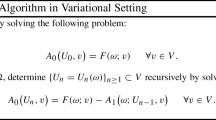Abstract
In this paper, we consider an inverse reaction–diffusion–convection problem in which one of the boundary conditions is unknown. A sixth-kind Chebyshev collocation method will be proposed to solve numerically this problem and to obtain the unknown boundary function. Since this inverse problem is generally ill-posed, to find an optimal stable solution, we will utilize a regularization method based on the mollification technique with the generalized cross-validation criterion. The error estimate of the numerical solution is investigated. Finally, to authenticate the validity and effectiveness of the proposed algorithm, some numerical test problems are presented.







Similar content being viewed by others
References
Arridge, S.R., Schotland, J.C.: Optical tomography: forward and inverse problems. Inverse Prob. 25, 123010 (2009)
Prato, M., Zanni, L.: Inverse problems in machine learning: an application to brain activity interpretation. J. Phys Conf. Ser. 135, 012085 (2008)
Ghosh Roy, D.N., Couchman, L.S.: Inverse Problems and Inverse Scattering of Plane Waves. Academic Press, New York (2002)
Beck, J.V., Blackwell, B., Clair, C.R.: Inverse Heat Conduction: Ill-Posed Problems, New York (1985)
Penenko, V., Baklanov, A., Tsvetova, E., Mahura, A.: Direct and inverse problems in a variational concept of environmental modeling. Pure Appl. Geophys. 169, 447–465 (2012)
Isakov, V.: Inverse Problems for Partial Differential Equations. Springer, New York (2006)
Prilepko, A.I., Orlovsky, D.G., Vasin, I.A.: Methods for Solving Inverse Problems in Mathematical Physics. Marcel Dekker, New York (2000)
Murio, D.A.: Time fractional IHCP with Caputo fractional derivatives. Comput. Math. Appl. 56, 2371–2381 (2008)
Babaei, A., Banihashemi, S.: Reconstructing unknown nonlinear boundary conditions in a time-fractional inverse reaction–diffusion–convection problem. Numer. Meth. Part. D. E. 35(3), 976–992 (2019)
Deng, Z.C., Hon, Y.C., Yang, L.: An optimal control method for nonlinear inverse diffusion coefficient problem. J. Optim. Theory Appl. 160, 890–910 (2014)
Shidfar, A., Babaei, A.: The Sinc-Galerkin method for solving an inverse parabolic problem with unknown source term. Numer. Meth. Part. Differ. Equ. 29, 64–78 (2013)
Zhou, J., Li, H., Xu, Y.: Ritz-Galerkin method for solving an inverse problem of parabolic equation with moving boundaries and integral condition. Appl Anal 98, 1–15 (2018)
Bhrawy, A.H., Abdelkawy, M.A.: Efficient spectral collocation algorithm for solving parabolic inverse problems. Int. J. Comput. Methods 13(6), 1650036 (2016)
Rostamian, M., Shahrezaee, A.: A meshless method to the numerical solution of an inverse reaction–diffusion–convection problem. Int. J. Comput. Math. 94(3), 597–619 (2017)
Babaei, A., Banihashemi, S.: A stable numerical approach to solve a time-fractional inverse heat conduction problem. Iran J. Sci. Technol. Trans. Sci. 42(4), 2225–2236 (2018)
Hamdi, A.: Identification of point sources in two dimensional advection–diffusion–reaction equation: application to pollution sources in a river. Stationary case, Inverse Prob. Sci. Eng. pp. 1–20,(2006)
Deolmi, G., Marcuzzi, F.: A parabolic inverse convection–diffusion–reaction problem solved using space-time localization and adaptivity. Appl. Math. Comput. 219, 8435–8454 (2013)
Murio, D.A.: Stable numerical solution of a fractional-diffusion inverse heat conduction problem. Comput. Math. Appl. 53, 1492–1501 (2007)
Woodbury, K.: Inverse Engineering Handbook. CRC Press, Boca Raton (2003)
Garshasbi, M., Dastour, H.: Estimation of unknown boundary functionsin an inverse heat conduction problem using a mollified marching scheme. Numer Algorithms 68(4), 769–790 (2015)
Masjed-Jamei, M.: A basic class of symmetric orthogonal polynomials using the extended Sturm–Liouville theorem for symmetric functions. J. Math. Anal. Appl. 325, 753–775 (2007)
Abd-Elhameed, W.M., Youssri, Y.H.: Sixth-kind Chebyshev spectral approach for solving fractional differential equations. Int. J. Nonlinear Sci. Numer. Simul. 20(2), 191–203 (2019)
Pirabaharan, P., Chandrakumar, R.D., Hariharan, G.: An efficient wavelet based approximation method for estimating the concentration of species and effectiveness factors in porous catalysts. MATCH 73, 705–727 (2015)
Author information
Authors and Affiliations
Corresponding author
Additional information
Publisher's Note
Springer Nature remains neutral with regard to jurisdictional claims in published maps and institutional affiliations.
Rights and permissions
About this article
Cite this article
Jafari, H., Babaei, A. & Banihashemi, S. A Novel Approach for Solving an Inverse Reaction–Diffusion–Convection Problem. J Optim Theory Appl 183, 688–704 (2019). https://doi.org/10.1007/s10957-019-01576-x
Received:
Accepted:
Published:
Issue Date:
DOI: https://doi.org/10.1007/s10957-019-01576-x
Keywords
- Inverse problem
- Reaction–diffusion–convection equation
- Sixth-kind Chebyshev polynomials
- Collocation method
- Mollification
- Error estimate




